Chelsea Women and Everton Women didn’t disappoint as a game with the scoreline suggesting a riot. While it was, the game did have it’s twists and turns with Everton making it slightly hard for Chelsea in parts but ultimately Emma Hayes’ team made it through to another three points.
This tactical analysis will detail the crucial tactics employed by Chelsea that won them the game and how they overcame Everton.
Line ups
Chelsea have made two changes from the side that faced Manchester City Women with Fran Kirby and Sam Kerr dropping out being replaced by Sophie Ingle and Bethany England. The addition of Ingle provides insurance against Everton’s quick runs specifically from Izzy Christensen. The rest of the team picked itself given their current form.
Everton Women have also made two changes with Valerie Gauvin and Lucy Graham being replaced by Nicoline Sørensen and Simone Magill. After dropping two points against Brighton & Hove Albion in their last FAWSL fixture, they were hoping to pick up points against Chelsea.
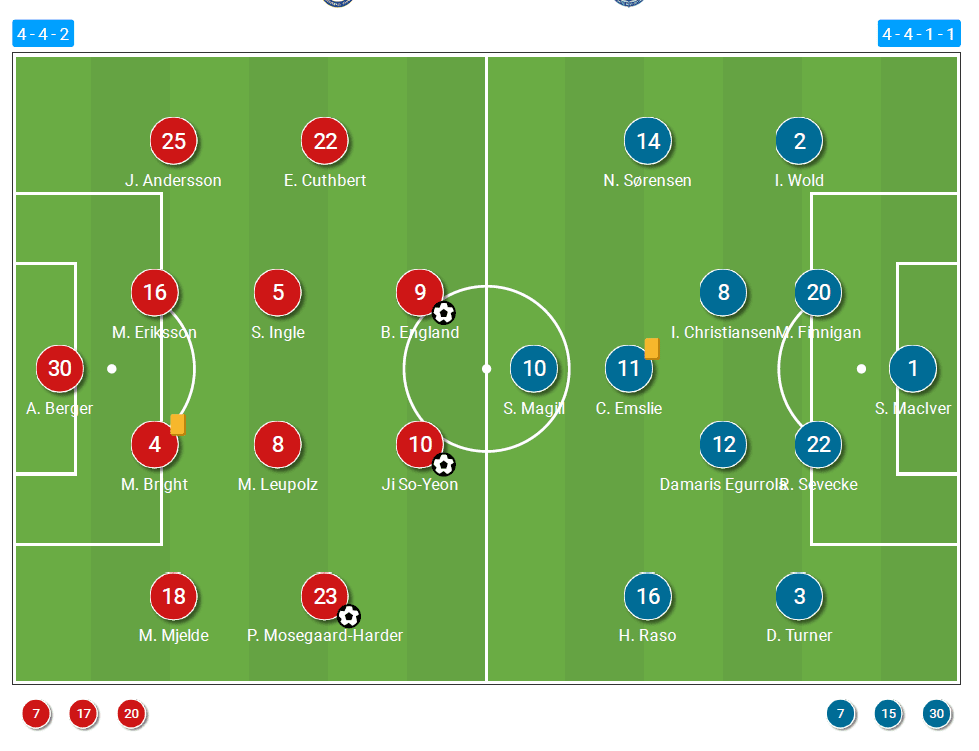
Chelsea Women attacking the half spaces
To start this analysis we’ll analyse Chelsea’s attacking tactics and how they approached the game against Everton’s defensive efforts. Right from the off, you could see Everton look to use a low block to combat Chelsea’s forward line. Coming up against a 4-2-3-1 system meant that Chelsea were always going to push four forwards to pressurise their back line and needed to be compact at the back to nullify them.
After using a variant of the 4-4-2 system, Hayes opted for the 4-2-3-1 which in essence was used to try and counteract Everton’s inevitable compact shape. Being able to play two narrow wide players and a creative attacking midfielder in the hole, Chelsea were effectively trying to play their way through from multiple angles and had a potent finisher in England at centre-forward. England’s selection over Kerr could have because of her incredible finishing and movement in the box. England’s understanding of space in the 18-yard box is understated and is one to finish even the toughest of chances. So being able to put away half-chances would have been in the thinking. That’s not to say Kerr is a worse finisher but with enough playmakers around Chelsea needed a clinical finisher.
Chelsea knew they were going to be blocked off from the central areas so their game plan was created around taking advantage of the half spaces where they could decide whether they needed to go wider or narrower with their passing. By playing the 4-2-3-1, Chelsea were able to get their creative attacking players closer to the ball and combine together to open up spaces. From here they wanted to play in crosses towards England and the opposite winger running in. The full-backs were there in support to provide a wider angle of cross but their main method came from inverted half space crosses from both Ji and Harder. Both Maren Mjelde and Jonna Andersson are not naturally attacking full-backs, however, they were given license to push forward and help out in attack making up the numbers.
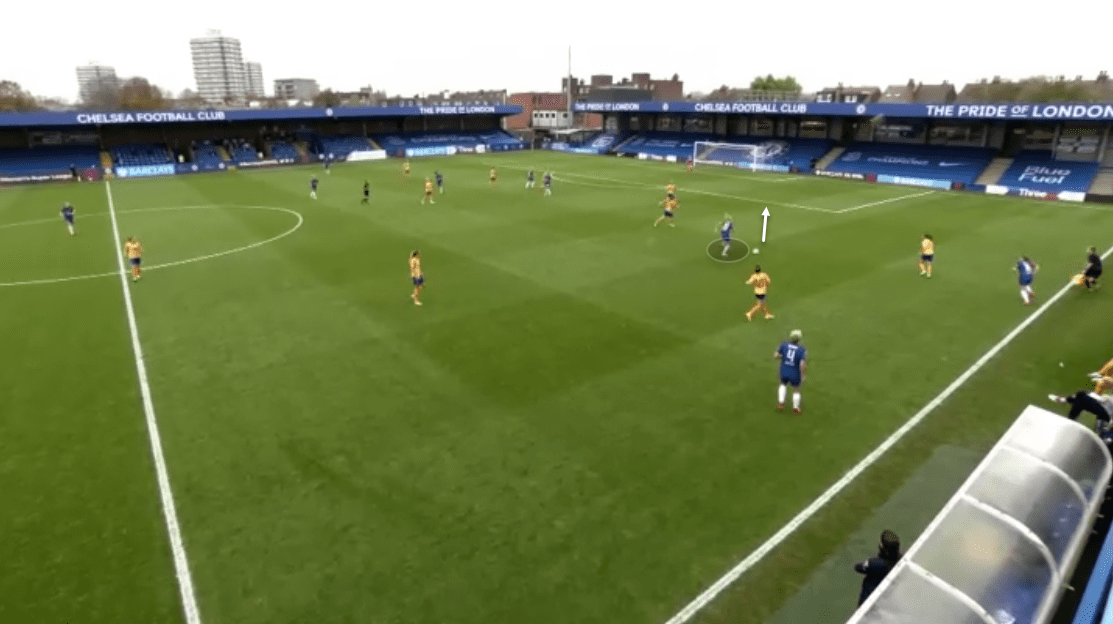
As this example shows, Chelsea were able to dominate this part of the pitch for much of the match and gave Everton numerous crosses to deal with. The presence of Mjelde, Bright, and Harder forces Everton to shift across leaving a gap between the full-back and centre-back. Harder wants to attack this space and get a ball into the box.
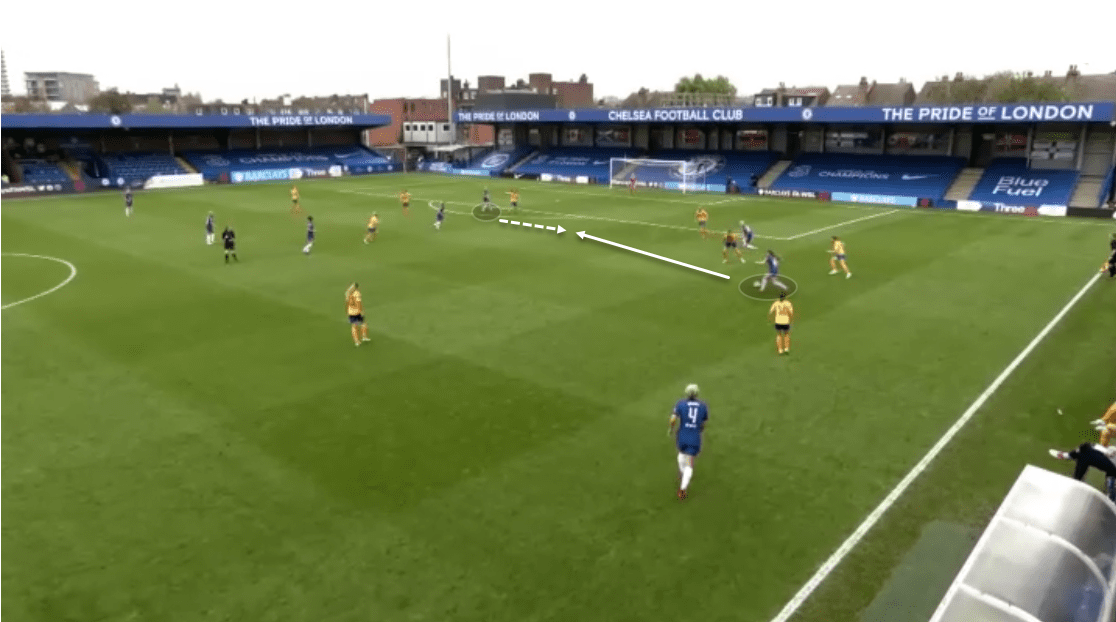
Though Harder gets dispossessed, instead of going down the flank, Mjelde drives inside and passes into England who wants to attack the highlighted space. These chances were few and far between as Chelsea were unable to properly hold onto possession for much of the first half. There were multiple times where Chelsea were sloppy in possession in midfield and gave up possession needlessly. This gave Everton a chance to attack but also halted their own momentum giving them time to organise themselves if there was another quick turnover back. The below cross map shows the frequency of crosses but not too many successful ones.
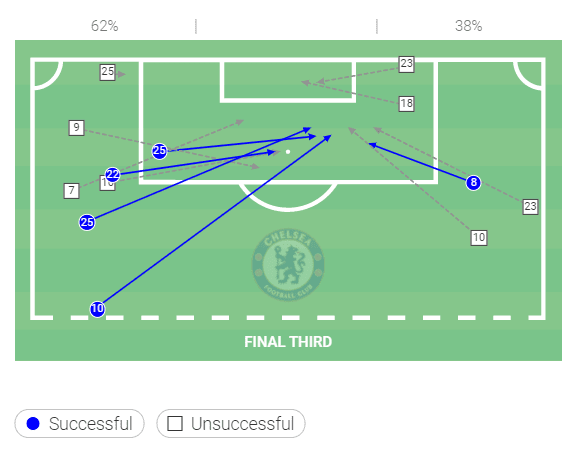
Chelsea’s second goal came in the second half when they managed to get a better foothold of the game. Their passing was much quicker at a higher tempo which was the source of their goal. Chelsea won back possession and made a quick pass forward which caught Everton off guard and allowed Chelsea to move between the lines as the image below shows.
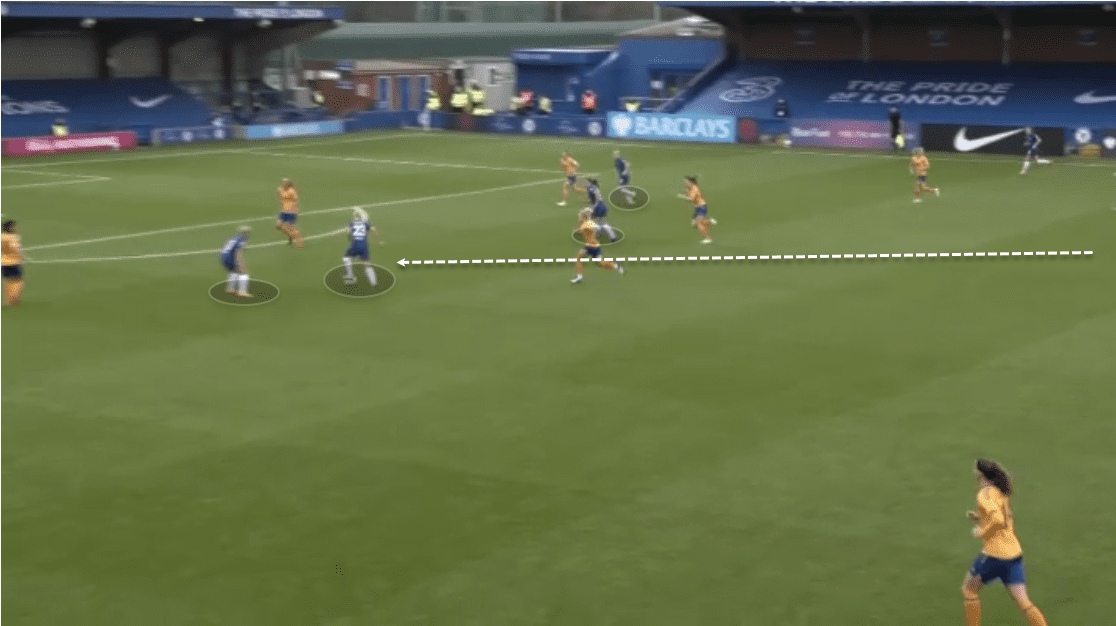
Negating Chelsea’s front four
Though Chelsea weren’t as fluid, they still created goal-scoring chances which forced Everton to sit back and press in deeper areas. Everton wanted to block off any space through the central areas whilst making sure they had enough cover out wide to stop the crosses.
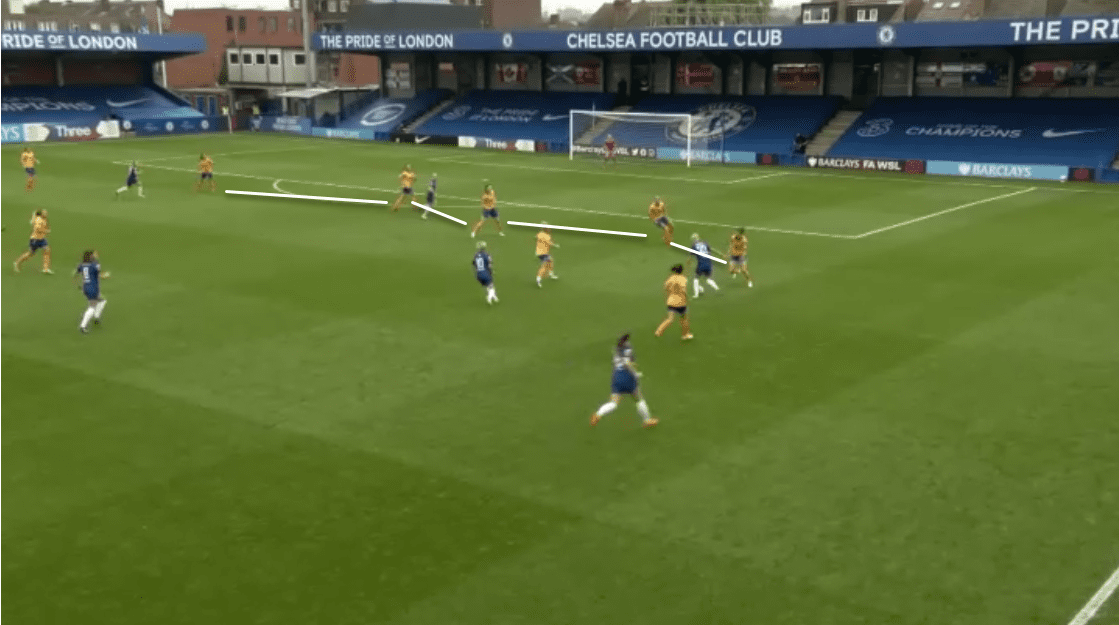
As the image here shows, Everton sat deep and instructed their wingers to fill in for their full-backs who tucked into narrower positions to stop any potential attacks. Chelsea wanted to dominate possession and Everton expected that and in doing so were prepared by playing with numbers at the back.
They instructed their wingers to drop back to stop Chelsea from creating those overloads in the wide areas. They employed a near man-marking system, which means they did mark man for man but also doubled up when Chelsea got into certain areas. Like they did against Manchester City, Everton were looking to create a square to suffocate and press Chelsea players at the top of the box as is seen below. In doing so, they forced them back meaning they had to find another way through.
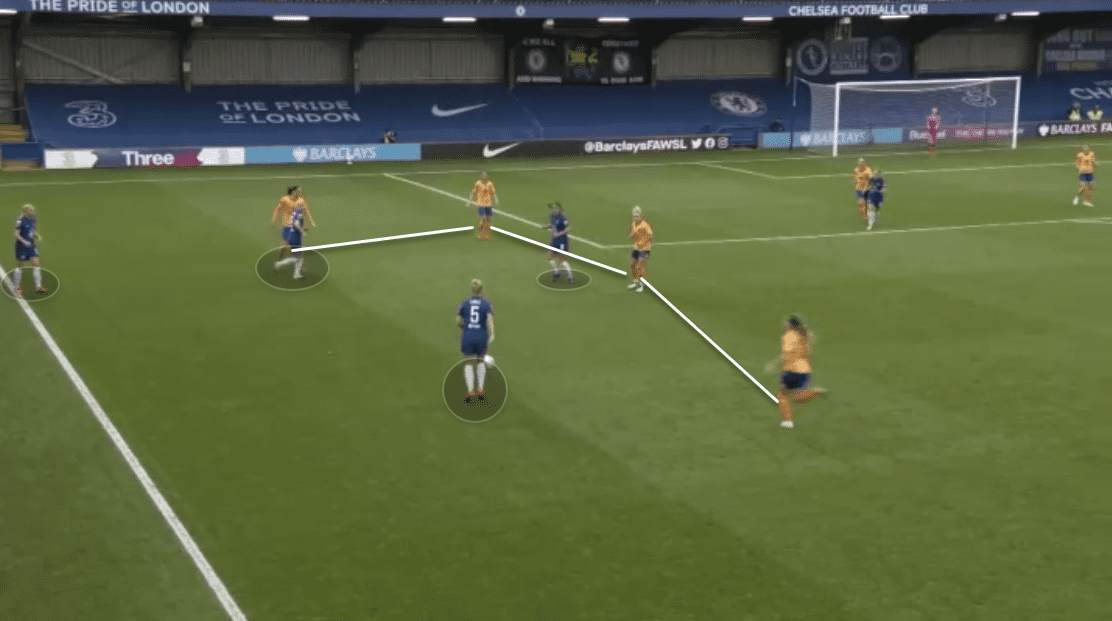
Here we can see Everton are matching Chelsea’s four players in the wide areas. Ingle is aiming to pass to Cuthbert who comes closer to receive but runs into traffic and has to run through the sea of Everton players.
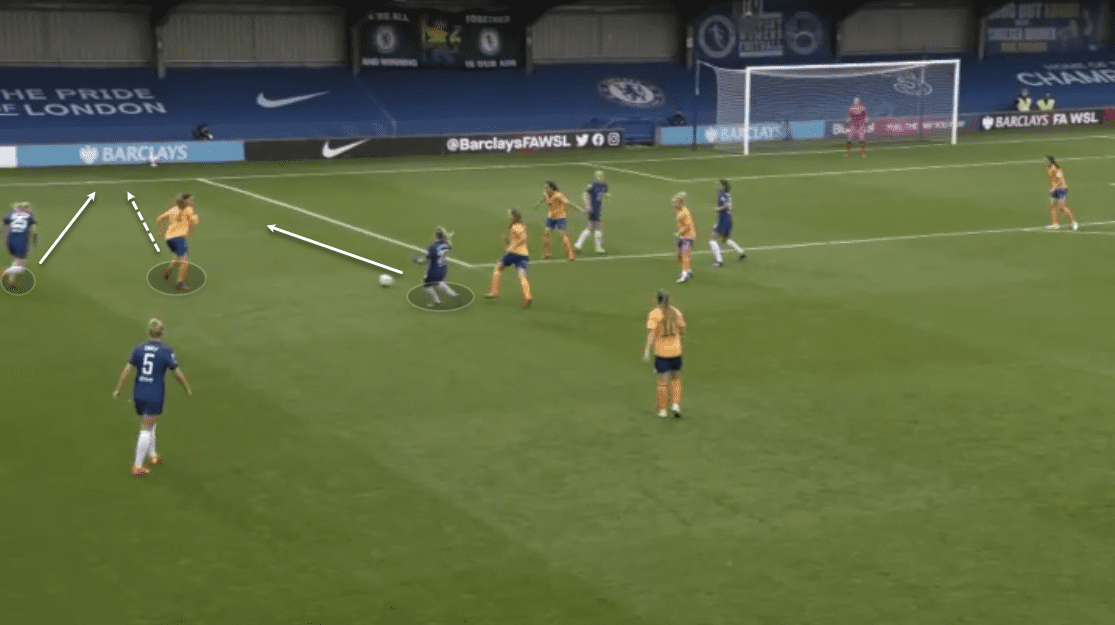
Cuthbert plays a pass down the line for Andersson to run on to but Sorensen has tracked back to intercept the pass and it goes out for a goal kick. This was a common theme throughout the game with Chelsea finding it hard to breakthrough. They took advantage of the lack of fluency in Chelsea’s passing by intercepting passes in midfield and counter-attack which didn’t allow Chelsea to play quickly.
Chelsea’s off the ball tactics vs Everton’s attacking strategy
A big part of Chelsea’s off the ball tactics has been their pressing, especially from the front. The key to beating Manchester City a couple of weeks ago was their high press which caught the Citizens out. Everton would have been prepared to face thus needed to be quick in their passing out from the back. Their attackers as expected looked to corner Everton in the wide areas to win it back and play in the furthest forward player. They often do this in a systematic way by not letting the ball carrier sit in possession for too long and every pass is met with a player going to recover the ball. This forced many a pass back to the goalkeeper which prompted her to go long thus switching possession back to Chelsea.
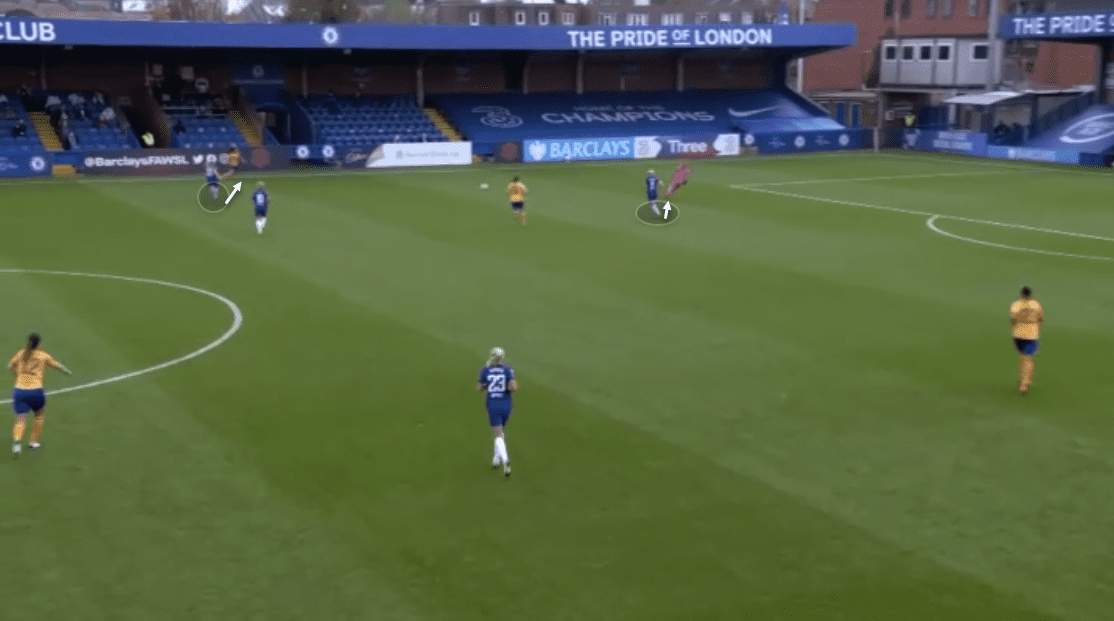
As the image here illustrates, Cuthbert and Ji have aggressively pressed Everton’s left-back who is now forced to pass it back to her goalkeeper. This came from England pressing the initial pass from Sandy MacIver. The return pass to MacIver is met with England closing down the English goalkeeper again who is now forced to go long. The resulting clearance is met with Chelsea winning a throw-in. This was a regular theme throughout the game especially in the first half where the Blues were able to put pressure on Everton’s defenders.
Equally, when Everton were in possession, Chelsea morphed into a 4-4-1-1 formation with the two wingers dropping deeper to help the full-backs. Harder was a noticeable figure continuously tracking back to aid Mjelde in keeping Hayley Raso shackled. Everton are gifted with a number of talented and quick midfielders and strikers so it needed discipline from the attacking quadrant to keep Everton at bay.
Chelsea were prepared to do the dirty work by putting in tackles. Cuthbert is naturally a keen defender full of energy so there was a natural inclination to focus play down the Harder/Mjelde right flank. Mjelde faced issues against Raso in their last meeting and while she had a much better showing this time around, the presence of Harder dropping deep and helping was a major factor in keeping Everton’s winger quiet. If we look at the duels map below, Harder had the most duels attempted with England coming second. Not only does it highlight Harder’s contribution defensively, it also supports the high press Chelsea employed. The map shows 36% of their duels coming in the final third especially across the two flanks.
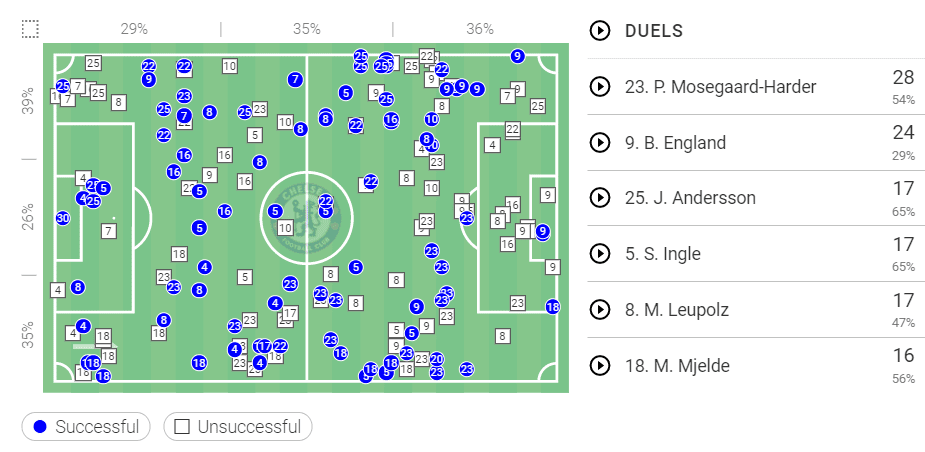
So this begs the question on Everton’s tactics to attack Chelsea. With Chelsea’s full-backs playing higher and more attacking this game, the two Everton wingers wanted to exploit the space left in behind. Though Chelsea compensated for this by moving one of the double-pivot across to cover the vacant space, the high rate of turnovers in midfield meant Chelsea were exposed in these areas.
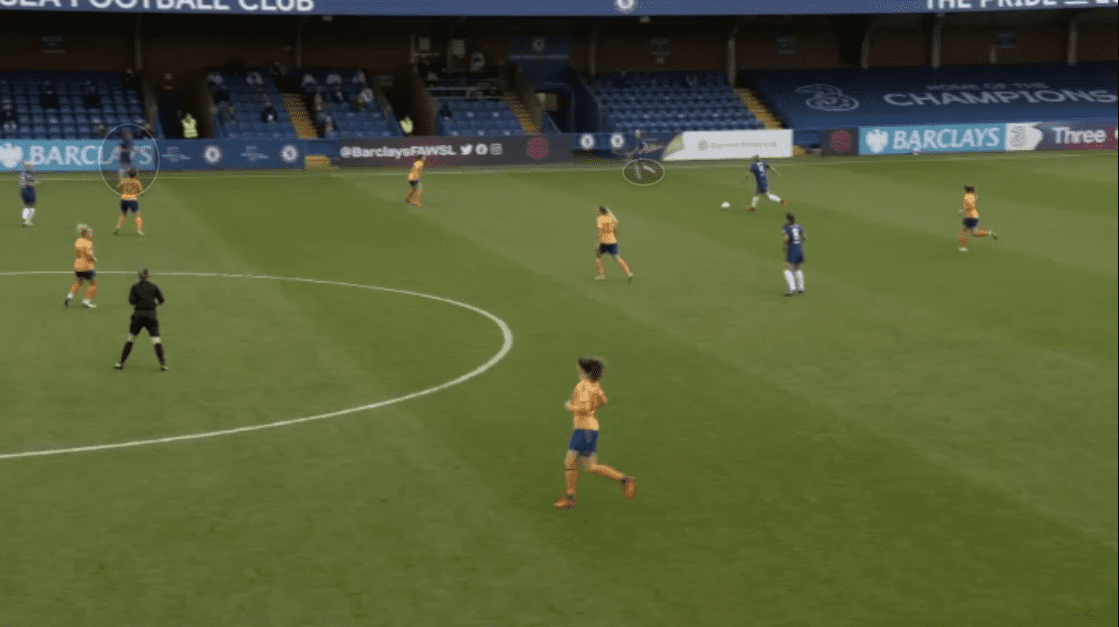
One of Ingle and Leupolz were tasked with slotting in to Mjelde and Andersson’s position when they bombed forward as is seen above. The idea was to keep 3-4 defenders at all times, and we’ve seen this successfully implemented by Olympique Lyon Feminin in France. These positional rotations, however, only work if there’s control in midfield and that was one area Chelsea faltered against Everton.
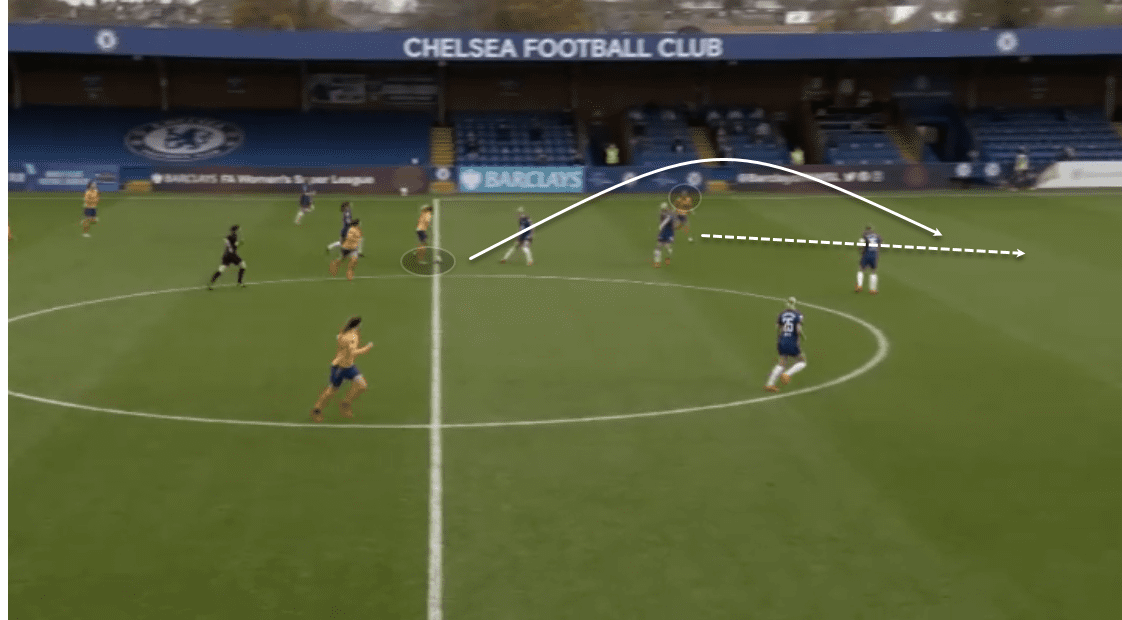
As we can see in the above image, Ingle moved into the right-back position as Chelsea advanced forward with Mjelde pushing high on the right. However, a miscued pass turned over possession and gave Everton an immediate counter-attacking opportunity. With a high line, Chelsea were left exposed with space in behind. Luckily for Chelsea, Everton were unable to capitalise on these opportunities and that is partly down to Gauvin’s absence. If they had a focal point and someone who is adept at finding space in the box, then the result could have been different. The game was evenly poised at 1-0 till the 70th minute by which time Everton had a plethora of chances to score.
Conclusion
To conclude, Chelsea deserved their win and 4-0 is a reflection of the number of chances they created and were eventually able to put away. They showed grit and determination to break down Everton’s resolute back five but against a more clinical team, they can be punished. Everton suffered their first defeat of the season and will take some heart from the performance. Chelsea Women entertain Arsenal Women next week and the Gunners will have had an eye on the performance here at Kingsmeadow.






Comments